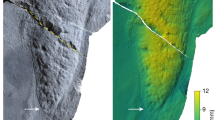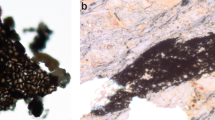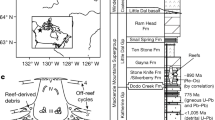Abstract
STROMATOPOROIDS are calcareous fossils abundant in many Palaeozoic (mainly Silurian and Devonian) shallow-water carbonate sediments. Forms ascribed to stromatoporoids have also been reported from Mesozoic epicontinental and tethyan carbonate deposits1. The nodular, tabular or cylindrical and, generally, vertically laminated calcitic skeletons of stromatoporoids (Fig. 1a), ranging in size from a few mm to > 1.0 m, are internally formed of curved plates, short or long pillars and vertical walls. A characteristic feature of many stromatoporoids are stellate structures, a few mm to 6–7 cm across, termed astrorhizae. In spite of 150 yr of investigation the systematic position of stromatoporoids is still controversial. They have been variously interpreted as foraminifers, sponges and hydrozoans2,3 with discussion on the latter two groups bearing particularly on the interpretation of the skeletal morphogenesis4,5. New discoveries6 of peculiar modern sponges with mixed calcareous and spicular siliceous skeletons (Sclerospongiae) reopened discussion on the relationship of this group to stromatoporoids, initiated at the beginning of the century by Kirkpatrick7,8. Hartman and Goreau's suggestion9 has been taken up and supported by Steam5,10 and Wendt11. Stearn argued that stromatoporoids should be recognised as a separate subphylum of the Porifera. Wendt similarly regarded stromatoporoids as a conservative order of the Calcispongiae closely related to the Pharetronida. Spicules, however, are quite unknown in stromatoporoids and the discovery of fossil (Cretaceous) sclerosponges with preserved spicules12,13 shows that their absence cannot arise from diagenetic dissolution as Hartman and Goreau suggested. Interpretation of the astro-rhizae is critical to any discussion of stromatoporoid affinities. As poriferans, the astrorhizae become traces left by the sponge exhalent canals, or as hydrozoans they are structures homologous to coenosarcal stolons (hydrorhizae). Kazmierczak14 rejected both interpretations and argued that astrorhizae are traces of foreign organisms probably commensal or mutualistic with stromatoporoids. The new observations reported here modify but confirm this.
This is a preview of subscription content, access via your institution
Access options
Subscribe to this journal
Receive 51 print issues and online access
$199.00 per year
only $3.90 per issue
Buy this article
- Purchase on Springer Link
- Instant access to full article PDF
Prices may be subject to local taxes which are calculated during checkout
Similar content being viewed by others
References
Flügel, E., Paläont. Z., 49, 369–406 (1975).
Lecompte, M., in Treatise on Invertebrate Paleontology, Part F (edit. by Moore, R. C. ), 107–144 (University of Kansas Press, Lawrence, 1956).
Galloway, J. J., Bull. Am. Paleont., 37, 345–480 (1957).
Kazmierczak, J., Palaeont. pol., 26, 1–150 (1971).
Stearn, C. W., Lethaia, 8, 89–100 (1974).
Hartman, W. D., Postilla, 137, 1–39 (1969).
Kirkpatrick, R., Nature, 89, 502–503 (1912).
Kirkpatrick, R., Nature, 89, 607 (1912).
Hartman, W. D., and Goreau, T. F., Symp. zool. Soc. Lond., 25, 205–243 (1970).
Stearn, C. W., Lethaia, 5, 369–388 (1972).
Wendt, J., N. Jb. Geol. Paläont. Abh., 150, 111–125 (1975).
Kazmierczak, J., Palaeontology, 17, 341–347 (1974).
Kazmierczak, J., and Hillmer, G., Acta palaeont. pol., 19, 443–453 (1974).
Kazmierczak, J., Acta palaeont. pol., 14. 499–535 (1969).
Stearn, C. W., Palaeontology, 9, 74–124 (1966).
Monty, C. L. V., Annls Soc. Géol. Belg., 90, 55–99 (1967).
Horodyski, R. J., and Vonder Haar, S. P., J. sedim. Petrol., 45, 894–906 (1975).
Fritsch, F. E., The Structure and Reproduction of the Algae, II (University Press, Cambridge, 1945).
Geitler, L., in Handbuch der Pflanzenanatomie, Bd. VI, Teil 1 (edit. by Zimmermann, W., and Ozenda, P. ), 1–131 (Gebruder Borntraeger, Berlin, 1960).
Knoll, A. H., Barghoorn, E. S., and Golubić, S., Proc. natn. Acad. Sci. U. S. A., 72, 2488–2492 (1975).
Geitler, L., Arch. Protistenk., 51, 321–360 (1925).
Drouet, F., in Manual of Phycology (edit. by Smith, G. M. ), 159–166 (Chronica Botanica Co., Waltham, Massachusetts, 1951).
Schopf, J. W., in Evolutionary Biology, 7 (edit. by Dobzhansky, T., Hecht, M. K., and Steere, W. C. ), 1–43 (Plenum New York, 1974).
Hofmann, H. J., Am. J. Sci., 275, 1121–1132 (1975).
Golubić, S., in The Biology of Blue-Green Algae (edit. by Carr, N. G., and Whitton, B. A. ), 434–472 (Blackwell, Oxford, 1973).
Kazmierczak, J., Acta palaeont. pol., 20, 73–85 (1975).
Author information
Authors and Affiliations
Rights and permissions
About this article
Cite this article
KAźMIERCZAK, J. Cyanophycean nature of stromatoporoids. Nature 264, 49–51 (1976). https://doi.org/10.1038/264049b0
Received:
Accepted:
Issue Date:
DOI: https://doi.org/10.1038/264049b0
This article is cited by
Comments
By submitting a comment you agree to abide by our Terms and Community Guidelines. If you find something abusive or that does not comply with our terms or guidelines please flag it as inappropriate.



